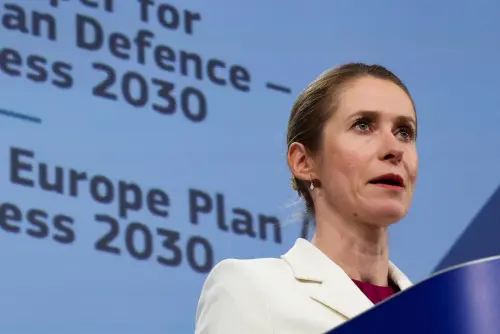Europe should increase military spending, pool resources for joint defense projects, and prioritize the purchase of European arms, according to a new EU blueprint unveiled to address concerns over Russia and uncertainties surrounding U.S. protection.
The European Commission introduced these proposals in a White Paper on defense, which aims to ensure that Europe maintains a "strong and sufficient" defense posture by 2030.
"The international order is undergoing changes of a magnitude not seen since 1945. This is a pivotal moment for European security," stated Kaja Kallas, the European Union's foreign policy chief.
Kallas noted that Russia's economy is operating in "full war mode," with 40% of its federal budget allocated to the military. She emphasized that regardless of ongoing peace negotiations regarding Ukraine, this reflects a long-term investment in a sustained plan of aggression.
Some of the proposed measures are designed to bolster the EU's arms industry, significantly limiting the role of companies from major arms producers outside the bloc, such as the United States, Britain, and Turkey.
EU nations have already heightened their defense capabilities in response to Russia's actions since 2022, increasing defense spending by over 30% between 2021 and 2024. However, the sense of urgency has intensified due to U.S. diplomatic overtures towards Russia, raising concerns that European security can no longer be Washington's foremost priority.
"450 million European Union citizens should not have to depend on 340 million Americans to defend ourselves against 140 million Russians, who cannot defeat 38 million Ukrainians," stated European Defence Commissioner Andrius Kubilius. "We can really do better. It's time for us to take responsibility for the defense of Europe."
The White Paper outlines the need to address "capability gaps" in critical areas such as air and missile defense, artillery, ammunition, drones, military transport, artificial intelligence, cyber warfare, and infrastructure protection. It proposes that EU countries quickly pool resources to address these gaps, including through Defense Projects of Common European Interest, which would be defined by governments and supported by EU financial incentives.
Moscow has condemned the EU’s rearmament efforts as an incitement to war, claiming it is based on an "invented story" of a Russian threat. However, such denials have not assuaged European leaders, as similar statements were made prior to the invasion of Ukraine.
The paper contains earlier proposals aimed at increasing countries’ defense spending. These include a plan for the Commission to borrow 150 billion euros for loans to EU governments for defense projects and to relax EU public finance rules, potentially mobilizing an additional 650 billion euros.
Traditionally, defense policy has fallen within the purview of national governments and the NATO alliance connecting North America and Europe. Nevertheless, the EU has taken on an increasingly significant role in defense over recent years, with the White Paper suggesting a fundamental shift toward a more pan-European approach.
While many EU governments support these initiatives, the logistics of implementation will likely spark intense debate over decision-making processes, project management, and funding.
The proposals will require approval from the bloc's national governments and, in some instances, the European Parliament to be enacted into law. The European Commission has suggested it could serve as a "central purchasing body" for EU members, though some capitals have expressed resistance, preferring such decisions to remain with national governments.
The paper also indicates that the Commission will work to establish a unified EU market for defense equipment, aiming to simplify and harmonize regulations. These measures seek to alleviate the fragmentation of Europe's defense industry, which currently features a multitude of manufacturers producing various weapons systems for different countries. For example, Europe has 19 different main battle tanks, compared to just one in the United States, and 17 types of torpedoes compared to two in the U.S., according to an analysis by McKinsey.
